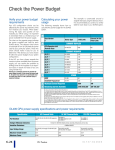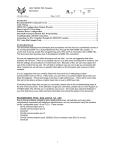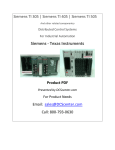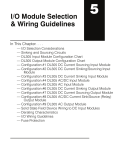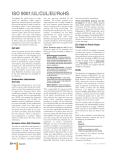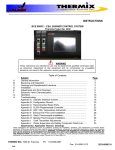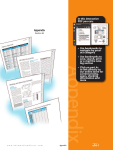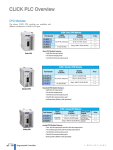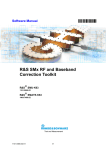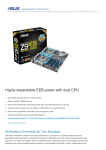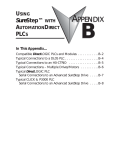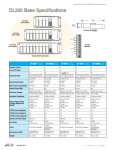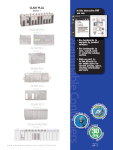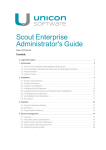Download 405 CoProcessor Modules
Transcript
CoProcessor Modules Company Information Systems Overview Programmable Controllers Basic CoProcessor Modules Field I/O Software C-more & other HMI F4-CP128-1 <---> F4-CP128-T <---> Drives Operator Interfaces Soft Starters Motors & Gearbox Steppers/ Servos Motor Controls Built-in telephone modem Proximity Sensors Features Overview The FACTS CoProcessor Module interfaces the DirectLOGIC 405 family of programmable controllers with bar code readers, operator interface terminals, instrumentation equipment, computers, and other serial devices. The three ports offer a range of communication interfaces and baud rates. Please consult the port descriptions to see which module is best suited for your needs. • FACTS Extended BASIC and ABM Commander for Window software makes program development fast and simple. Allows ONLINE, full-screen BASIC program editing and the ability to save programs on disk (software on CD included with each module) • Non-volatile memory of up to 128K bytes allows multiple program storage and execution, DL405 register expansion, and retentive data storage and retrieval • 16 MHz or 26 MHz CoProcessor provides fast program execution independent of the DL405 CPU scan • Three buffered ports permit communication from module to three or more external devices • Programmable from either port for complete serial port utilization without having to switch cables • A real-time clock/calendar maintains time/date with battery backup when power outages occur. Programmable time-based BASIC interrupts to .005 of a second •Directly access up to 254 bytes of DL405 CPU memory per scan. No supporting ladder logic is required •Floating point math solves complex formulas to eight significant digits •Options include a built-in 300/1200/2400 baud telephone modem •Includes Modbus master/slave BASIC examples and other application examples on CD Photo Sensors CoProcessor applications Limit Switches The CoProcessors are designed for use with intelligent devices such as: • Barcode readers • Welders • Board level controllers • Serial printers • Intelligent sensors • Almost any device with an RS-232/422/485 port CoProcessors are also good solutions for applications requiring large amounts of complex math. Encoders Current Sensors Pressure Sensors Temperature Sensors Pushbuttons/ Lights Process Relays/ Timers Comm. Terminal Blocks & Wiring Power Circuit Protection Enclosures Tools Pneumatics Appendix Product Index Part # Index Volume 13 w w w. a u to m at i o n d i re c t . c o m / d l 405 Programmable Controllers e6-39 CoProcessor Modules Specifications Module Type Modules per CPU CoProcessor, intelligent Eight maximum, any slot in CPU base Communication 256 character type-ahead input buffer on all ports. Ports are independently programmed by software. Seven or eight data bits, 1 or 2 stop bits, even, odd or no parity. XON/XOFF software flow control and RTS/CTS handshake. F4-CP128-1 128K bytes of battery-backed RAM. 26MHz clock rate. Runs BASIC programs two to three times faster than 16MHz CoProcessors. Port 1, RS232C/422/485 selectable, maximum baud rate of 115.2K baud. Port 2, RS232C/422/485 selectable, maximum baud rate 57.6K baud. Port 3, RS232C, maximum baud rate of 19.2K baud. Port 3 is available by using the RTS/CTS pins on Port 1. If you use these lines on Port 1, then Port 3 is not available. F4-CP128-T 128K bytes of battery-backed RAM, 16 MHz clock rate. Port 1, RS232C/422/485 selectable, maximum baud rate of 57.6K baud. Port 2, RS232C, maximum baud rate 9600 baud. An optional use for port 2 is a built-in full-duplex, 300/1200/2400 baud PSK/FSK, asynchronous telephone modem. The modem is Bell 212A/103 & CCITT V.22/V.21 compatible. Automatic dialer with call progress monitoring detects no dial tone, ring and busy. Automatically answer calls. Can be used for remote data acquisition and diagnostics. Allows remote reprogramming of both BASIC CoProcessor and DirectLOGIC 405 CPUs. Exceeds FCC part 68 hazard protection requirements. Port 3, RS232C, maximum baud rate of 9600 baud. Port 3 is available by using the RTS/CTS pins on Port 1. If you use these lines on Port 1, then Port 3 is not available. ABM Commander for Windows (CD-ROM included with module) Programming/documentation software for FACTS Engineering BASIC module. Key features include: • Runs under Windows 95/98/2000 or Windows NT 3.51 or later. • Command Mode allows the user to program and debug with a "Point and Click" or Command Line Interface. • Uses standard Windows applications for off-line edited (Notepad) and terminal emulation (Hyperterminal) • Text Upload and Download BASIC programs • Binary Upload and Download BASIC programs • Extensive help file contains full user manual information • Includes Modbus master and Modbus slave BASIC programs and other application examples Field Termination 9 pin D-sub connectors for port 1 and port 2. Port 3 uses electrical connections from port 1. (F4-CP128-T uses an RJ12 phone jack located under the module) Power Consumption F4-CP128-1 — 305mA maximum at 5VDC, (supplied by base power supply) F4-CP128-T — 350mA maximum at 5VDC, (supplied by base power supply) Operating Environment 0°C-60°C (32°F-140°F), 5% to 95% humidity (non-condensing) Manufacturer FACTS Engineering Volume 13 e6-40 Programmable Controllers 1 - 80 0 - 633 - 0405 Check the Power Budget Verify your power budget requirements This logo is placed next to I/O modules that are supported by the ZIPLink connection systems. See the I/O module specifi- Calculating your power usage Your I/O configuration choice can be affected by the power requirements of the I/O modules you choose. When determining the types and quantity of I/O modules you will be using, it is important to remember there is a limited amount of power available from the power supply. cations at the end of this section. The following example shows how to calculate the power budget for the DL405 system. The example is constructed around a single 8-slot base using the devices shown. It is recommended you construct a similar table for each base in your system. The chart on the opposite page indicates the power supplied and used by each DL405 device. The adjacent chart shows an example of how to calculate the power used by your particular system. These two charts should make it easy for you to determine if the devices you have chosen fit within the power budget of your system configuration. A Base Number 0 B Use ZIPLinks to reduce power requirements If your application requires a lot of relay outputs, consider using the ZipLink AC or DC relay output modules. These modules can switch high current (10A) loads without putting a load on your base power budget. Refer to page 6-57 for more information. 5 VDC (mA) External 24 VDC Power (mA) CURRENT SUPPLIED CPU/Expansion Unit /Remote Slave D4-440 CPU C 3700 400 CURRENT REQUIRED SLOT 0 SLOT 1 SLOT 2 SLOT 3 SLOT 4 SLOT 5 SLOT 6 SLOT 7 D4-16ND2 +150 +0 D4-16ND2 +150 +0 F4-04DA +120 +100 D4-08ND3S +100 +0 D4-08ND3S +100 +0 D4-16TD2 +100 +0 D4-16TD2 +100 +0 D4-16TR +1000 +0 BASE Handheld Programmer D4-08B +80 +0 D4-HPP +320 +0 E Maximum Current Required 2820 100 F Remaining Current Available 3700-2820=880 400-100=300 If the I/O you have chosen exceeds the maximum power available from the power supply, you can resolve the problem by shifting some of the modules to an expansion base or remote I/O base (if you are using remote I/O). Warning: It is extremely important to calculate the power budget correctly. If you exceed the power budget, the system may operate in an unpredictable manner which may result in a risk of personal injury or equipment damage. Device Type D OTHER 1. Using a chart similar to the 3one above, fill in column 2. 2. Using the tables on the opposite page, enter the current supplied and used by each device (columns 3 and 4). Pay special attention to the current supplied by the CPU, Expansion Unit, and Remote Slave since they differ. Devices which fall into the "Other" category (Row D) are devices such as the Base and the Handheld programmer, which also have power requirements, but do not plug directly into the base. 3. Add the current used by the system devices (columns 3 and 4) starting with Slot 0 and put the total in the row labeled "maximum current required" (Row E). 4. Subtract the row labeled "Maximum current required" (Row E), from the row labeled "Current Supplied" (Row B). Place the difference in the row labeled "Remaining Current Available" (Row F). 5. If "Maximum Current Required" is greater than "Current Supplied" in either column 3 or 4, the power budget will be exceeded. It will be unsafe to use this configuration and you will need to restructure your I/O configuration. Note the auxiliary 24 VDC power supply does not need to supply all the external power. If you need more than the 400mA supplied, you can add an external 24VDC power supply. This will help keep you within your power budget for external power. DL405 CPU power supply specifications and power requirements Specification Part Numbers AC Powered Units D4-450, D4-440, D4-430, D4-EX (expansion base unit), D4-RS (remote slave unit) Voltage Withstand (dielectric) Insulation Resistance 24 VDC Powered Units D4-450DC-1, D4-440DC-1, D4-EXDC (expansion base unit), D4-RSDC (remote slave unit) 125 VDC Powered Units D4-450DC-2 D4-440DC-2 1 minute @ 1,500 VAC between primary, secondary, field ground, and run relay > 10M at 500VDC Input Voltage Range 85-132 VAC (110 range) 170-264 VAC (220 range 20-28 VDC (24 VDC) with less than 10% ripple 90-146 VDC (125 VDC) with less than 10% ripple Maximum Inrush Current Maximum Power 20 A 20 A 20 A 50 VA 38 W 30 W Volume 13 e6-24 Programmable Controllers 1 - 80 0 - 633 - 0405 Power Requirements Company Information Systems Overview Programmable Controllers Power Supplied CPUs/Remote Units/ Expansion Units 5 VDC Current Supplied in mA 24V Aux Power Supplied in mA CPUs/Remote Units/Expansion Units 5V Current Supplied in mA 24VAux. Power Supplied in mA D4-430 CPU D4-440 CPU D4-440DC-1 CPU D4-440DC-2 CPU D4-450 CPU D4-450DC-1 CPU D4-450DC-2 CPU 3700 3700 3700 3700 3100 3100 3100 400 400 NONE NONE 400 NONE NONE D4-EX D4-EXDC D4-EXDC-2 D4-RS D4-RSDC H4-EBC H4-EBC-F 4000 4000 3700 3700 3700 3470 3300 400 NONE NONE 400 NONE 400 400 Field I/O Software C-more & other HMI Drives Power Consumed Power-consuming Device I/O Bases 5V Current Consumed D4-04B-1 D4-06B-1 D4-08B-1 80 80 80 External 24VD Current Required NONE NONE NONE DC Input Modules D4-08ND3S D4-16ND2 D4-16ND2F D4-32ND3-1 D4-32ND3-2 D4-64ND2 100 150 150 150 150 300 max. NONE NONE NONE NONE NONE NONE Power-consuming 5V Current Device Consumed Analog Modules (continued) External 24VDC Current Required F4-16AD-1 F4-16AD-2 F4-04DA-1 F4-04DA-2 F4-04DAS-1 F4-04DAS-2 F4-08DA-1 F4-08DA-2 F4-16DA-1 F4-16DA-2 F4-08RTD F4-08THM-n F4-08THM 100 100 75+20per circuit 90 60 per circuit 60 per circuit 100+20 per circuit 150 100+20 per circuit 25 max. NONE 50 60 75 75 70 90 60 60 90 80 90 80 80 120 110 Motors & Gearbox 100 150 Photo Sensors Limit Switches NONE NONE H4-ERM H4-ERM-F D4-RM 320 450 300 NONE NONE NONE Pressure Sensors Temperature Sensors 150 90 D4-08TD1 F4-08TD1S D4-16TD1 D4-16TD2 D4-32TD1 D4-32TD1-1 D4-32TD2 150 295 200 400 250 250 350 D4-64TD1 800 NONE NONE 35 NONE 125 NONE 140 140 (15V) 120 (4A max including loads) NONE Communications and Networking H4-ECOM100 H4-ECOM H4-ECOM-F D4-DCM F4-MAS-MB FA-UNICON 300 530 670 500 235 NONE Pushbuttons/ Lights NONE NONE NONE NONE NONE 65 Process Relays/ Timers Comm. CoProcessors F4-CP128-1 Terminal Blocks & Wiring 305 NONE Power AC Output Modules 250 450 NONE NONE Relay Output Modules D4-08TR F4-08TRS-1 F4-08TRS D4-16TR Proximity Sensors Current Sensors DC Output Modules D4-08TA D4-16TA Motor Controls Encoders AC/DC Input Modules D4-16NE3 F4-08NE3S Steppers/ Servos Remote I/O AC Input Modules D4-08NA D4-16NA Soft Starters 550 575 575 1000 NONE NONE NONE NONE Specialty Modules H4-CTRIO D4-INT D4-HSC F4-16PID F4-8MPI D4-16SIM F4-4LTC Circuit Protection 400 100 300 160 225 150 280 NONE NONE NONE NONE 170 NONE 75 Enclosures Tools Pneumatics Appendix Analog Modules Programming 320 NONE Product Index DV-1000 150 NONE Part # Index C-more Micro-Graphic 210 NONE D4-HPP-1 (Handheld Prog.) F4-04AD F4-04ADS F4-08AD 85 270 75 100 120 90 Operator Interface Volume 13 w w w. a u to m at i o n d i re c t . c o m / d l 405 Programmable Controllers e6-25




